MGT602 Business Decision Analytics: A Comprehensive Decision Analysis
VerifiedAdded on 2023/05/29
|6
|1237
|100
Report
AI Summary
This report presents a decision style analysis, identifying a balanced decision-making style based on personal preferences. It includes a decision diary to track responses and reflections on decisions made. The analysis contrasts intuition-based and logic-based decision-making, advocating for a balanced approach grounded in reliable facts. The report also covers the identification of personal type and shadow type, highlighting the importance of maintaining balance and addressing potential impatience or disappointment. Feedback from a mentoring session reinforces the suitability of a balanced decision-making style. Recommendations include engaging more deeply with issues before making decisions and utilizing careful, balanced thinking with fewer emotions. Desklib offers a wealth of similar resources for students.
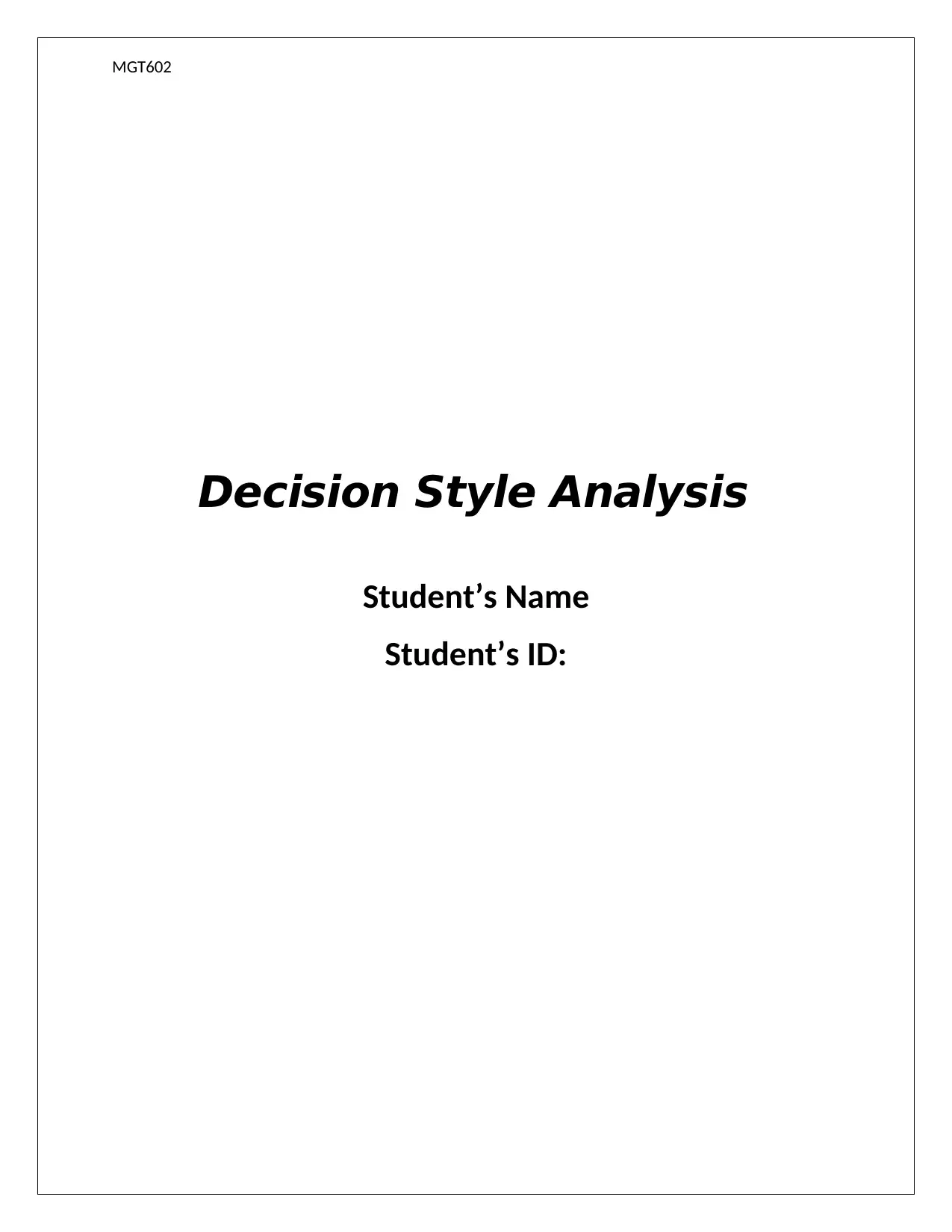
MGT602
Decision Style Analysis
Student’s Name
Student’s ID:
Decision Style Analysis
Student’s Name
Student’s ID:
Paraphrase This Document
Need a fresh take? Get an instant paraphrase of this document with our AI Paraphraser
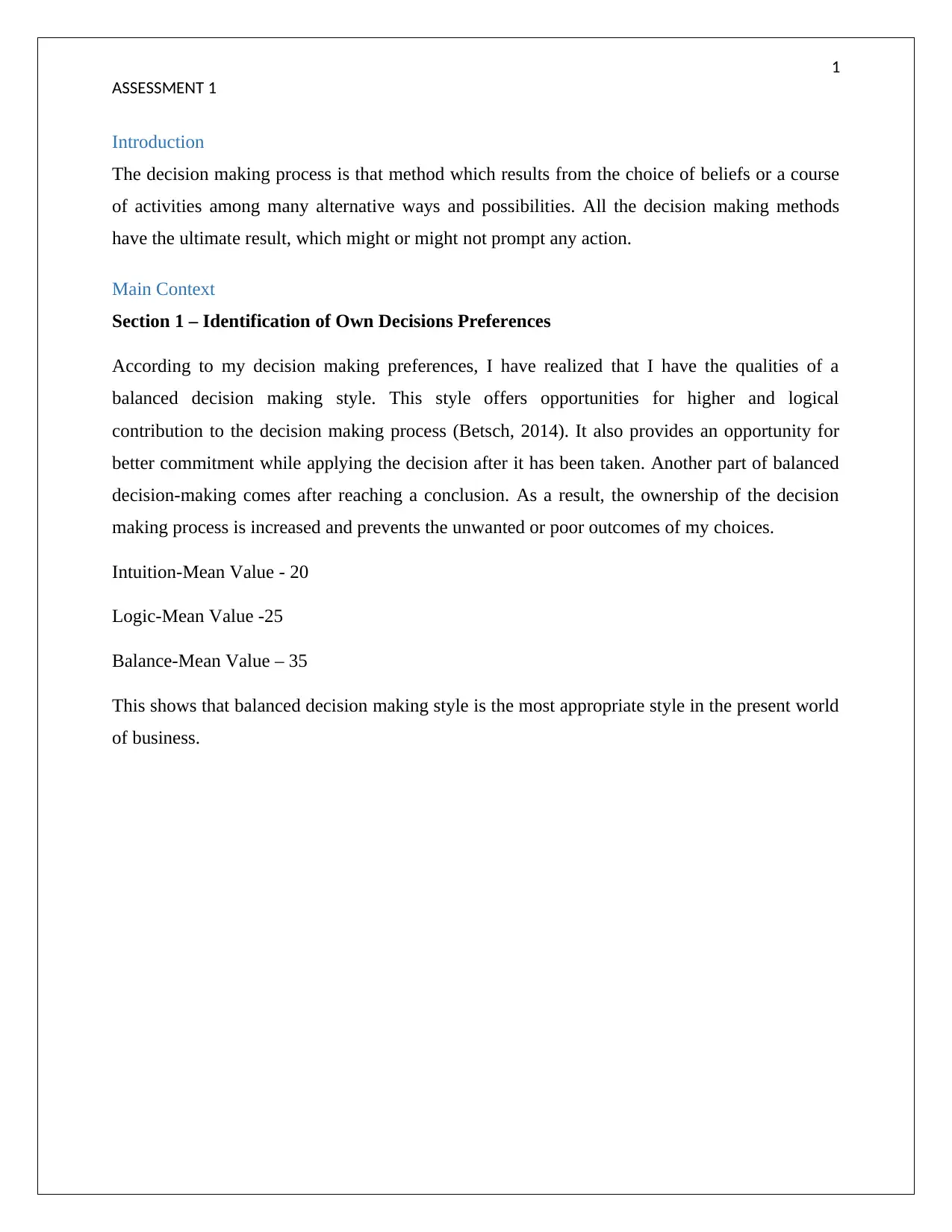
1
ASSESSMENT 1
Introduction
The decision making process is that method which results from the choice of beliefs or a course
of activities among many alternative ways and possibilities. All the decision making methods
have the ultimate result, which might or might not prompt any action.
Main Context
Section 1 – Identification of Own Decisions Preferences
According to my decision making preferences, I have realized that I have the qualities of a
balanced decision making style. This style offers opportunities for higher and logical
contribution to the decision making process (Betsch, 2014). It also provides an opportunity for
better commitment while applying the decision after it has been taken. Another part of balanced
decision-making comes after reaching a conclusion. As a result, the ownership of the decision
making process is increased and prevents the unwanted or poor outcomes of my choices.
Intuition-Mean Value - 20
Logic-Mean Value -25
Balance-Mean Value – 35
This shows that balanced decision making style is the most appropriate style in the present world
of business.
ASSESSMENT 1
Introduction
The decision making process is that method which results from the choice of beliefs or a course
of activities among many alternative ways and possibilities. All the decision making methods
have the ultimate result, which might or might not prompt any action.
Main Context
Section 1 – Identification of Own Decisions Preferences
According to my decision making preferences, I have realized that I have the qualities of a
balanced decision making style. This style offers opportunities for higher and logical
contribution to the decision making process (Betsch, 2014). It also provides an opportunity for
better commitment while applying the decision after it has been taken. Another part of balanced
decision-making comes after reaching a conclusion. As a result, the ownership of the decision
making process is increased and prevents the unwanted or poor outcomes of my choices.
Intuition-Mean Value - 20
Logic-Mean Value -25
Balance-Mean Value – 35
This shows that balanced decision making style is the most appropriate style in the present world
of business.

2
ASSESSMENT 1
Section 2 - Keep a Decision Diary
I prefer acting on decisions that look right rather than those feel right as I have some methods
that are followed by me. It does not need to follow the exact logic of the decision making
process (Vohs et al., 2018). But I like to approach the decisions the same method each time,
instead of doing something different each time. The gut feelings tell to act instantly to avoid a
worse situation (Schapira et al., 2016).
I am always encouraged by others to be rational in my decision making process. In order to make
the output, some inputs are needed, and the methods have to be good. Rational thinking is the
capability to consider some particular variables of the circumstances and access, arrange and
analyze them to get some reliable data to reach the best conclusion.
I prefer to be objective in justifying my decisions to others as because I am not influenced by
personal emotions, viewpoints, interests, and partialities of others. The present situation of
information has led to a higher rate of emotional decision making. The minds of the persons are
more likely to work and as a result, the chances of emotional decision-making increases
(Govindan, Rajendran, Sarkis & Murugesan, 2015).
Section 3 – Identification of Own Type and Shadow Side
Own Type
According to the personality test, I have the decisive, creative, insight and motivation qualities to
make a great impact on the world. I have the capability to take strong measures to understand my
targets and make a long-lasting effect. This type of personality have a unique combination of
characteristics, they have strong views and fight determinedly in their believed concept, in spite
of being soft spoken. They are decisive and have strong will powers but seldom utilizes them for
their personal purposes (Spreng, Karlawish & Marson, 2016).
Shadow Type
I always try to maintain a balance through the ideal circumstance is not still possible. This type
of personality is likely to take active measures in the way of their targets, and if their routine
works get worst, they perceive that they have no target in their life and feel impatient and
disappointed (Shay & Lafata, 2015
ASSESSMENT 1
Section 2 - Keep a Decision Diary
I prefer acting on decisions that look right rather than those feel right as I have some methods
that are followed by me. It does not need to follow the exact logic of the decision making
process (Vohs et al., 2018). But I like to approach the decisions the same method each time,
instead of doing something different each time. The gut feelings tell to act instantly to avoid a
worse situation (Schapira et al., 2016).
I am always encouraged by others to be rational in my decision making process. In order to make
the output, some inputs are needed, and the methods have to be good. Rational thinking is the
capability to consider some particular variables of the circumstances and access, arrange and
analyze them to get some reliable data to reach the best conclusion.
I prefer to be objective in justifying my decisions to others as because I am not influenced by
personal emotions, viewpoints, interests, and partialities of others. The present situation of
information has led to a higher rate of emotional decision making. The minds of the persons are
more likely to work and as a result, the chances of emotional decision-making increases
(Govindan, Rajendran, Sarkis & Murugesan, 2015).
Section 3 – Identification of Own Type and Shadow Side
Own Type
According to the personality test, I have the decisive, creative, insight and motivation qualities to
make a great impact on the world. I have the capability to take strong measures to understand my
targets and make a long-lasting effect. This type of personality have a unique combination of
characteristics, they have strong views and fight determinedly in their believed concept, in spite
of being soft spoken. They are decisive and have strong will powers but seldom utilizes them for
their personal purposes (Spreng, Karlawish & Marson, 2016).
Shadow Type
I always try to maintain a balance through the ideal circumstance is not still possible. This type
of personality is likely to take active measures in the way of their targets, and if their routine
works get worst, they perceive that they have no target in their life and feel impatient and
disappointed (Shay & Lafata, 2015
⊘ This is a preview!⊘
Do you want full access?
Subscribe today to unlock all pages.

Trusted by 1+ million students worldwide
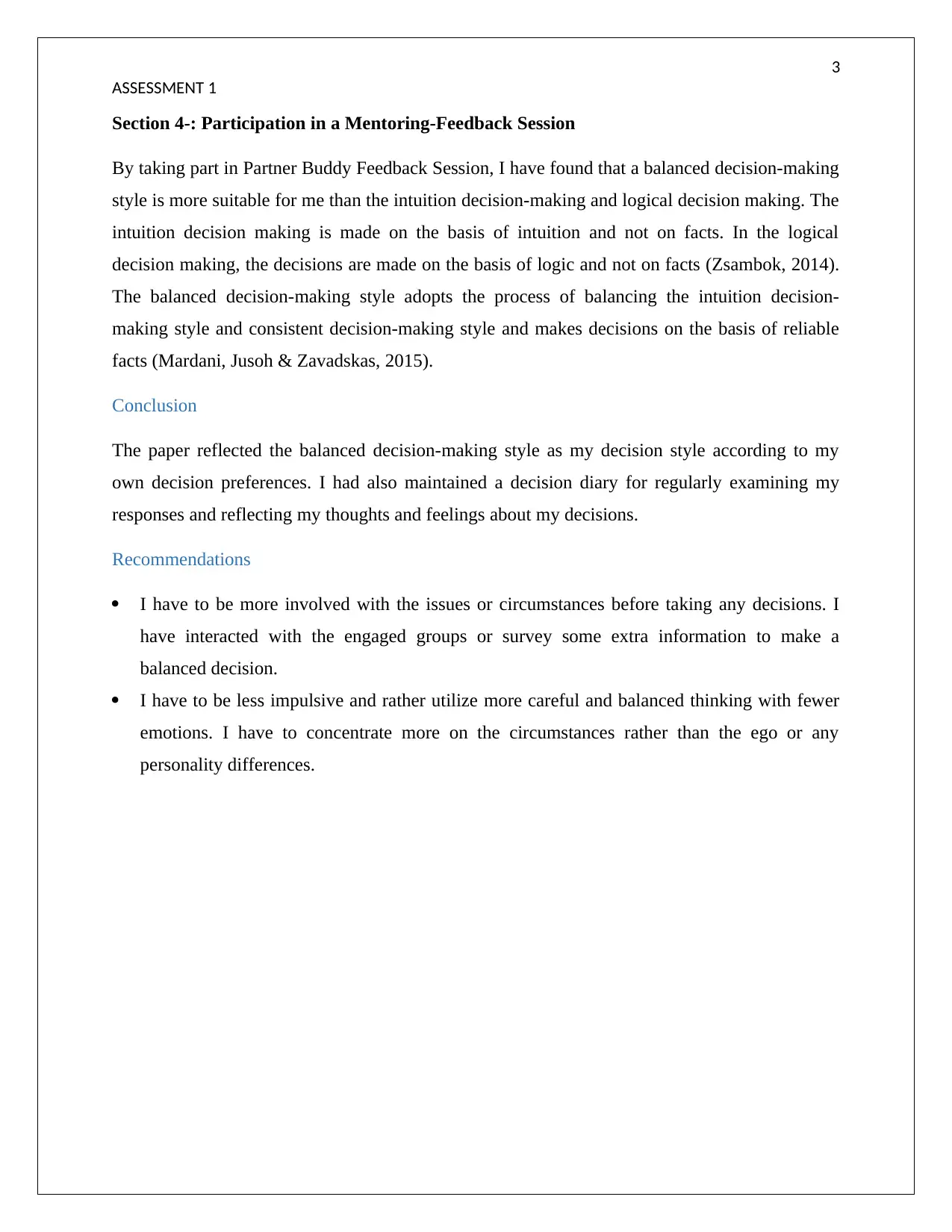
3
ASSESSMENT 1
Section 4-: Participation in a Mentoring-Feedback Session
By taking part in Partner Buddy Feedback Session, I have found that a balanced decision-making
style is more suitable for me than the intuition decision-making and logical decision making. The
intuition decision making is made on the basis of intuition and not on facts. In the logical
decision making, the decisions are made on the basis of logic and not on facts (Zsambok, 2014).
The balanced decision-making style adopts the process of balancing the intuition decision-
making style and consistent decision-making style and makes decisions on the basis of reliable
facts (Mardani, Jusoh & Zavadskas, 2015).
Conclusion
The paper reflected the balanced decision-making style as my decision style according to my
own decision preferences. I had also maintained a decision diary for regularly examining my
responses and reflecting my thoughts and feelings about my decisions.
Recommendations
I have to be more involved with the issues or circumstances before taking any decisions. I
have interacted with the engaged groups or survey some extra information to make a
balanced decision.
I have to be less impulsive and rather utilize more careful and balanced thinking with fewer
emotions. I have to concentrate more on the circumstances rather than the ego or any
personality differences.
ASSESSMENT 1
Section 4-: Participation in a Mentoring-Feedback Session
By taking part in Partner Buddy Feedback Session, I have found that a balanced decision-making
style is more suitable for me than the intuition decision-making and logical decision making. The
intuition decision making is made on the basis of intuition and not on facts. In the logical
decision making, the decisions are made on the basis of logic and not on facts (Zsambok, 2014).
The balanced decision-making style adopts the process of balancing the intuition decision-
making style and consistent decision-making style and makes decisions on the basis of reliable
facts (Mardani, Jusoh & Zavadskas, 2015).
Conclusion
The paper reflected the balanced decision-making style as my decision style according to my
own decision preferences. I had also maintained a decision diary for regularly examining my
responses and reflecting my thoughts and feelings about my decisions.
Recommendations
I have to be more involved with the issues or circumstances before taking any decisions. I
have interacted with the engaged groups or survey some extra information to make a
balanced decision.
I have to be less impulsive and rather utilize more careful and balanced thinking with fewer
emotions. I have to concentrate more on the circumstances rather than the ego or any
personality differences.
Paraphrase This Document
Need a fresh take? Get an instant paraphrase of this document with our AI Paraphraser
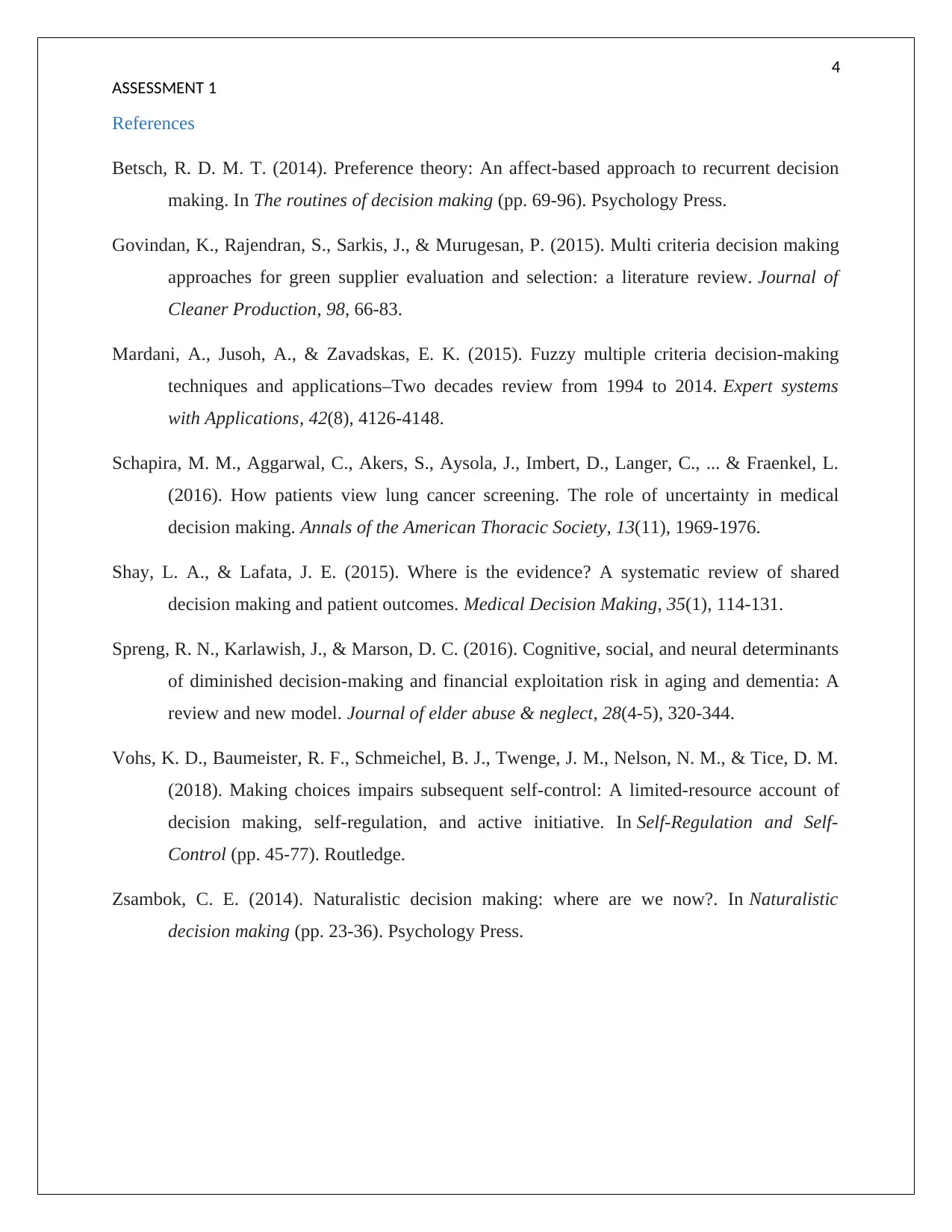
4
ASSESSMENT 1
References
Betsch, R. D. M. T. (2014). Preference theory: An affect-based approach to recurrent decision
making. In The routines of decision making (pp. 69-96). Psychology Press.
Govindan, K., Rajendran, S., Sarkis, J., & Murugesan, P. (2015). Multi criteria decision making
approaches for green supplier evaluation and selection: a literature review. Journal of
Cleaner Production, 98, 66-83.
Mardani, A., Jusoh, A., & Zavadskas, E. K. (2015). Fuzzy multiple criteria decision-making
techniques and applications–Two decades review from 1994 to 2014. Expert systems
with Applications, 42(8), 4126-4148.
Schapira, M. M., Aggarwal, C., Akers, S., Aysola, J., Imbert, D., Langer, C., ... & Fraenkel, L.
(2016). How patients view lung cancer screening. The role of uncertainty in medical
decision making. Annals of the American Thoracic Society, 13(11), 1969-1976.
Shay, L. A., & Lafata, J. E. (2015). Where is the evidence? A systematic review of shared
decision making and patient outcomes. Medical Decision Making, 35(1), 114-131.
Spreng, R. N., Karlawish, J., & Marson, D. C. (2016). Cognitive, social, and neural determinants
of diminished decision-making and financial exploitation risk in aging and dementia: A
review and new model. Journal of elder abuse & neglect, 28(4-5), 320-344.
Vohs, K. D., Baumeister, R. F., Schmeichel, B. J., Twenge, J. M., Nelson, N. M., & Tice, D. M.
(2018). Making choices impairs subsequent self-control: A limited-resource account of
decision making, self-regulation, and active initiative. In Self-Regulation and Self-
Control (pp. 45-77). Routledge.
Zsambok, C. E. (2014). Naturalistic decision making: where are we now?. In Naturalistic
decision making (pp. 23-36). Psychology Press.
ASSESSMENT 1
References
Betsch, R. D. M. T. (2014). Preference theory: An affect-based approach to recurrent decision
making. In The routines of decision making (pp. 69-96). Psychology Press.
Govindan, K., Rajendran, S., Sarkis, J., & Murugesan, P. (2015). Multi criteria decision making
approaches for green supplier evaluation and selection: a literature review. Journal of
Cleaner Production, 98, 66-83.
Mardani, A., Jusoh, A., & Zavadskas, E. K. (2015). Fuzzy multiple criteria decision-making
techniques and applications–Two decades review from 1994 to 2014. Expert systems
with Applications, 42(8), 4126-4148.
Schapira, M. M., Aggarwal, C., Akers, S., Aysola, J., Imbert, D., Langer, C., ... & Fraenkel, L.
(2016). How patients view lung cancer screening. The role of uncertainty in medical
decision making. Annals of the American Thoracic Society, 13(11), 1969-1976.
Shay, L. A., & Lafata, J. E. (2015). Where is the evidence? A systematic review of shared
decision making and patient outcomes. Medical Decision Making, 35(1), 114-131.
Spreng, R. N., Karlawish, J., & Marson, D. C. (2016). Cognitive, social, and neural determinants
of diminished decision-making and financial exploitation risk in aging and dementia: A
review and new model. Journal of elder abuse & neglect, 28(4-5), 320-344.
Vohs, K. D., Baumeister, R. F., Schmeichel, B. J., Twenge, J. M., Nelson, N. M., & Tice, D. M.
(2018). Making choices impairs subsequent self-control: A limited-resource account of
decision making, self-regulation, and active initiative. In Self-Regulation and Self-
Control (pp. 45-77). Routledge.
Zsambok, C. E. (2014). Naturalistic decision making: where are we now?. In Naturalistic
decision making (pp. 23-36). Psychology Press.
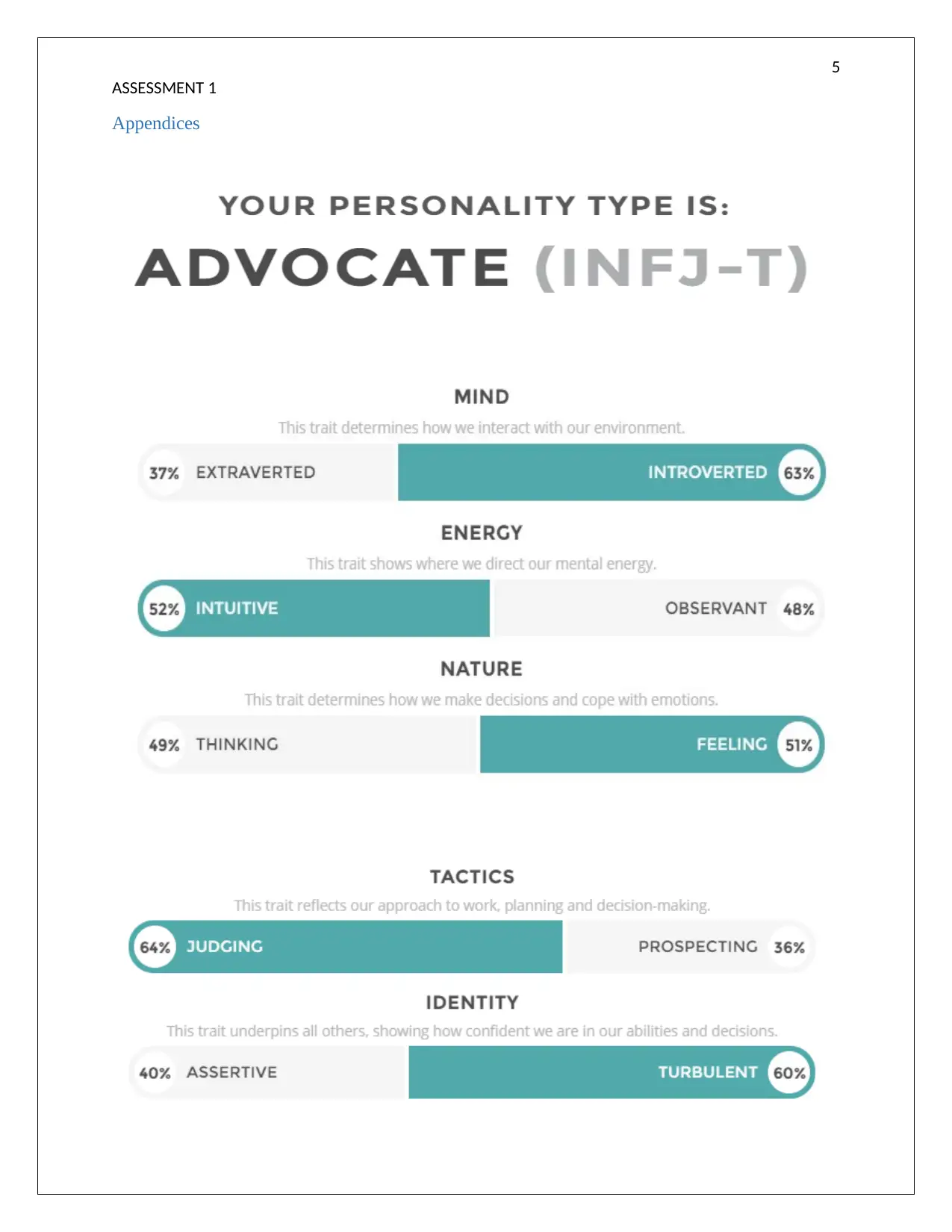
5
ASSESSMENT 1
Appendices
ASSESSMENT 1
Appendices
⊘ This is a preview!⊘
Do you want full access?
Subscribe today to unlock all pages.

Trusted by 1+ million students worldwide
1 out of 6
Related Documents
Your All-in-One AI-Powered Toolkit for Academic Success.
+13062052269
info@desklib.com
Available 24*7 on WhatsApp / Email
![[object Object]](/_next/static/media/star-bottom.7253800d.svg)
Unlock your academic potential
Copyright © 2020–2025 A2Z Services. All Rights Reserved. Developed and managed by ZUCOL.




